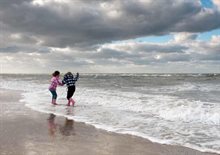European Marine Strategy Framework Directive
The public consultation period for the Draft Marine Strategy Part 1 2024–2030 was open from Tuesday 3 June to Monday 14 July 2025. The draft was accessible via the Platform Participation website, where responses could also be submitted.
The European Marine Strategy Framework Directive (MSFD), published in 2008, aims to protect and, where necessary, restore the Good Environmental Status (GES) of marine waters in Europe's seas and oceans. It is of the utmost importance that this objective is set at the European level. Marine ecosystems, the conditions that support them and all that influences them often transcend national boundaries. The same applies to many maritime uses and their impacts on the marine environment..

Structure of the MSFD
The Marine Strategy Framework Directive (MSFD) requires each EU Member State to establish a marine strategy for its own marine waters. This strategy must aim to protect, preserve and restore the marine environment (to GES), while also ensuring the sustainable use of the North Sea. Member States are obliged to take the necessary measures to achieve good environmental status in their marine waters.
In doing so, they must cooperate both with other EU Member States and with non-EU countries within their shared marine region. The MSFD recommends making full use of existing regional sea conventions and treaties where possible. The Dutch section of the North Sea falls under the scope of the OSPAR Convention, the regional sea convention for the North-East Atlantic.
The MSFD requires EU Member States to:
- assess the current environmental status of their marine waters, based on a set of descriptors provided by the MSFD;
- establish targets and implement measures aimed at restoring and maintaining Good Environmental Status (GES);
- develop a monitoring programme to track changes in the marine environment and evaluate the effectiveness of the measures taken;
- incorporate the MSFD obligations into their own national legislation and regulatory frameworks; and
- report periodically to the European Commission on all elements of the MSFD.
In 2010, the Netherlands transposed the MSFD into national legislation and it is currently implemented in Dutch law as part of the Environment and Planning Act (Omgevingswet).
The Dutch Marine Strategy for the North Sea consists of three parts, published at two-year intervals. Each part covers a six-year cycle and is then updated accordingly.
- Marine Strategy Part 1 (2018–2024) describes the current environmental status, the desired Good Environmental Status, environmental targets, descriptors and indicators.
- Marine Strategy Part 2 (2020–2026) outlines the MSFD monitoring programme and explains how the Netherlands carries this out.
- Marine Strategy Part 3 (2022–2027) presents the Programme of Measures that the Netherlands has drawn up and is implementing to achieve GES. This document is annexed to the North Sea Programme 2022–2027.
The updating process includes the preparation of public documents and associated EU reporting. The Dutch Cabinet formally adopts the parts of the Marine Strategy following a mandatory public consultation procedure
EU reporting and assessment
Member States must report to the EU on the updates to their marine strategies within three months. This is done through electronic submissions using a standardised data structure. The Marine Information and Data Centre (Informatiehuis Marien) coordinates these electronic reports in the Netherlands and is closely involved in the preparation of the public-facing documents.
Based on the electronic reports submitted for the three parts of the Marine Strategy, the EU assesses the extent to which the Netherlands complies with the requirements of the MSFD.
Cooperation within marine regions
The MSFD identifies specific European marine regions in which EU Member States are required to cooperate, preferably by making maximum use of existing regional sea conventions. Each Member State must develop a marine strategy for its own marine waters, which must also be coherent with the wider marine region to which it belongs. In this way, the cooperation required under the MSFD is achieved implicitly.
Neighbouring countries determine the content and scope of their cooperation themselves, which can take place at all levels in principle. A crucial aspect of this cooperation is achieving scientific consensus on the indicators used in each country’s monitoring programme. These indicators, structured under the eleven descriptors and associated criteria, determine whether or not GES has been achieved. While many indicators have now been established, others are still under development.
Partners within a marine region deliberate on these matters through the OSPAR Convention or EU-level collaboration. The specific criteria involved, and the levels at which agreement must be reached, are laid out in the European Commission Decision on criteria and methodological standards on Good Environmental Status of marine waters, and specifications and standardised methods for monitoring and assessment (2017).
This decision on the MSFD can be accessed via EUR-Lex, the official portal for EU law.
At present, there are three MSFD areas in the Dutch part of the North Sea: the Central Oyster Grounds, Borkum Reef Grounds and Frisian Front. In the future, the Southern Dogger Bank will also be designated as an MSFD area.